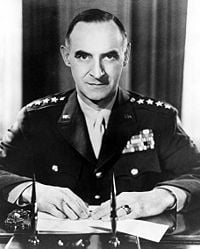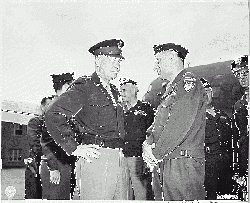Lucius D. Clay
| General Lucius D. Clay | |
|---|---|
| April 23, 1897 – April 16, 1978 | |
 | |
| Place of birth | Marietta, Georgia |
| Place of death | Chatham, Massachusetts |
| Allegiance | United States Army |
| Years of service | 1918–1949 |
| Rank | General |
| Commands held | Military Governor |
| Battles/wars | World War II |
| Awards | Distinguished Service Medal(2) Legion of Merit Bronze Star Medal Bundesverdienstkreuz |
| Relations | Son of US Senator Alexander Stephens Clay (Georgia) Father of General Lucius D. Clay, Jr. |
General Lucius Dubignon Clay (April 23, 1897 – April 16, 1978) was an American general and military governor best known for his administration of Germany immediately after World War II. Deputy to General Eisenhower, 1945; deputy military governor, Germany (U.S.) 1946; commander in chief, U.S. Forces in Europe and military governor, U.S. Zone, Germany, 1947–49; retired 1949. Clay is considered the "father" of the Berlin Airlift (1948–49) when supplies were flown into Berlin during the Soviet blockade. The task he faced in post-World War II was daunting. The population had to be fed, industry had to be switched from war-time to peace-time pursuits, the whole nation was demilitarized and new leaders had to be identified at the same time as Nazi war criminals were being tracked and tried. The implications of partition also had to be dealt with. He was an early supporter of some form of European integration, which he believed would help to keep the peace by eliminating a nationalistic element involved in competition.[1]
The Allies policy on restructuring the German economy kept changing. Initially, the plan was to severely restrict economic growth, before deciding that economic rehabilitation was preferable. Clay supported and lobbied for this change of policy, fearing that an impoverished Germany might find communism more attractive. The policy change appears to have been successful, because from the early 1950s the West German economy emerged as one of the strongest in Europe. The punitive limits that had been placed on industrial development were lifted in 1951, when Germany became a partner in the European Coal and Steel Community, from which the European Union later evolved.
Clay was a man whose training was for war, but he had the foresight to see an economically prosperous Germany was much less likely to see war as an attractive option.
Early Life
Clay was born on April 23, 1898,[2] Marietta, Georgia, the sixth and last child of Alexander Stephens Clay, who served in the U.S. Senate from 1897 to 1910, and a direct descendant of the statesman Henry Clay.[3] Lucius Clay graduated from West Point in 1918 and was married the same year on September 21 to Marjorie McKeown.[4] He held various civil and military engineering posts during the 1920s and 1930s, including teaching at West Point, directing the construction of dams and civilian airports, and by 1942 rising to the position of the youngest brigadier general in the Army. All the while he acquired a reputation for bringing order and operational efficiency out of chaos, and for being an exceptionally hard and disciplined worker, going long hours and refusing to even stop to eat during his workdays.
World War II
Clay did not see combat but accumulated the Legion of Merit in 1942, the Distinguished Service Medal in 1944, and received the Bronze Star Medal for his action in stabilizing the French harbor of Cherbourg, abandoned by German forces immediately after D-Day and critical to the flow of war material. In 1945 he served as deputy to General Dwight D. Eisenhower. The following year, he was made Deputy Governor of Germany during the Allied Military Government.
He heavily influenced United States Secretary of State, James F. Byrnes, September 1946 speech in Stuttgart. The speech, "Restatement of Policy on Germany" marked the formal transition in U.S. occupation policy away from the Morgenthau Plan influenced policy of economic dismantlement of Germany and towards a policy of economic reconstruction.
From 1947 to 1949, he was the Military Governor for the U.S. Zone in Germany, and in that capacity commissioned Lewis H. Brown to research and write "A Report on Germany," which served as a detailed recommendation for the reconstruction of post-war Germany, and served as a basis for the Marshall Plan. Clay was promoted to lieutenant general on April 17, 1945, and to general on March 17, 1947. During this time he hired noted American intellectual and former U.S. Army Captain, Melvin J. Lasky. Clay would be instrumental in the creation of the influential publication Der Monat.
On June 25, 1948, one day after the Soviets imposed the Berlin Blockade, Clay gave the order for the Berlin Airlift. This was an act of defiance against the Soviets, an incredible feat of logistics (at one point cargo planes landed at Tempelhof every four minutes, twenty four hours a day), a defining moment of the Cold War, and a demonstration of American support for the citizens of Berlin.
Clay is remembered as a hero for ordering and maintaining the airlift, which would ultimately last 324 days, through May 1949. He resigned his post days after the blockade was lifted.
Retirement
After Clay retired from the military, he went into politics and served several presidents. In 1954, he was called upon by U.S. President Dwight D. Eisenhower, to help forge a plan for financing the proposed Interstate highway system in an effort to see to its ultimate creation.[5] He had previous experience in 1933 with managing and organizing projects under the New Deal, and later became one of Eisenhower's closest advisers. During the Berlin Wall crisis in 1961, President John F. Kennedy asked him to be an adviser and to go to Berlin and report on the situation.
Clay died in his sleep on April 17, 1978.[6] Clay lies buried in West Point Cemetery. At his grave site is a stone plate from the citizens of Berlin that says: "Wir danken dem Bewahrer unserer Freiheit" (We thank the Preserver of our Freedom).
Legacy
Among many other honors, Clay was given a ticker-tape parade upon his return to the United States on May 19, 1949. He appeared on the cover of Time magazine three times. Clay also received an honorary doctorate of the Freie Universität Berlin and became honorary citizen of Berlin (West) in 1953. One of the longest streets in West Berlin was named Clayallee in his honor, as was the Clay Headquarters Compound, which was located on the street. It held the headquarters of the Berlin Brigade, U.S. Army Berlin (USAB), and the U.S. Mission in Berlin. Marietta, Georgia named one of its major streets Clay Street in honor of his work in creating what is now Dobbins Air Force Base there. While now called South Marietta Parkway (State Route 120 Loop), it still carries memorial signs at each end dedicating the highway to him.
Clay's son, General Lucius D. Clay, Jr.,[7] held the positions of commander-in-chief of the North American Air Defense Command, the Continental Air Defense Command, and the United States element of NORAD, and was also a commander of the U.S. Air Force Aerospace Defense Command.
Clay was highly dedicated to serving his country and seeing to its advancement. He had exceptionable organizational skills and was an excellent planner. Clay was also efficient at ensuring that his plans and goals were well executed.
Awards and decorations
- Distinguished Service Medal with Oak Leaf Cluster
- Legion of Merit
- Bronze Star Medal
- American Defense Service Medal
- American Campaign Medal
- European-African-Middle Eastern Campaign Medal
- World War II Victory Medal
- Army of Occupation Medal
- Bundesverdienstkreuz (Grand Cross)
Notes
- ↑ Richard D. McKinzie, (interviewer), "Oral History Interview with Lucius D. Clay," reply to question 24, Harry S Truman Library and Museum, July 16, 1974. Oral History Interview with Lucius D. Clay Retrieved January 23, 2008
- ↑ Jean Edward Smith, Lucius D. Clay: An American Life (New York: Henry, Holt & Company, 1990, ISBN 9780805009996), 25. Smith also notes that the army records date his birth to April 23, 1897, a year in advance of the actual date. This was due to the fact that Clay lied about his age in order to enter West Point early.
- ↑ Smith, Lucius D. Clay, 26.
- ↑ Smith, Lucius D. Clay, 44.
- ↑ Smith, Lucius D. Clay, 617.
- ↑ Smith, Lucius D. Clay, 685.
- ↑ United States Air Force, Biographies: General Lucius D. Clay, Jr., Lucius D. Clay, Jr. USAF Biography Retrieved January 23, 2008.
ReferencesISBN links support NWE through referral fees
- Backer, John H. Winds of History: The German Years of Lucius Dubignon Clay. New York: Van Nostrand Reinhold, 1983. ISBN 9780442213824
- Smith, Jean Edward. Lucius D. Clay: An American Life. New York: Henry, Holt & Company, 1990. ISBN 9780805009996
- Smith, Jean Edward. The Papers Of General Lucius D. Clay. Bloomington, IN: Indiana University Press, 1974.
- United States Air Force, Biographies: General Lucius D. Clay, Jr., Lucius D. Clay, Jr. USAF Biography Retrieved January 23, 2008.
External links
All links retrieved November 4, 2022.
- Interview with General Lucius D. Clay
- Clay's role in the US highway system
- Lucius D. Clay New Georgia Encyclopedia
- Bell Bomber
| Preceded by: Joseph T. McNarney |
Commanding General of U.S. Army Europe 15 March 1947 to 15 May 1949 |
Succeeded by: Clarence R. Huebner |
Credits
New World Encyclopedia writers and editors rewrote and completed the Wikipedia article in accordance with New World Encyclopedia standards. This article abides by terms of the Creative Commons CC-by-sa 3.0 License (CC-by-sa), which may be used and disseminated with proper attribution. Credit is due under the terms of this license that can reference both the New World Encyclopedia contributors and the selfless volunteer contributors of the Wikimedia Foundation. To cite this article click here for a list of acceptable citing formats.The history of earlier contributions by wikipedians is accessible to researchers here:
The history of this article since it was imported to New World Encyclopedia:
Note: Some restrictions may apply to use of individual images which are separately licensed.
